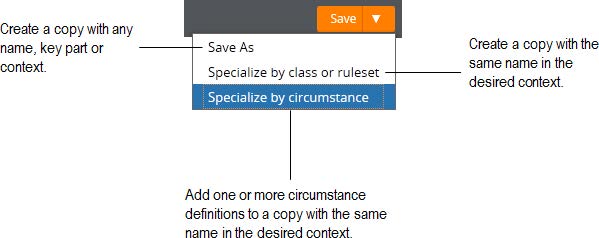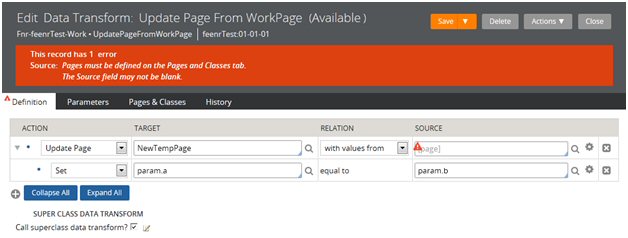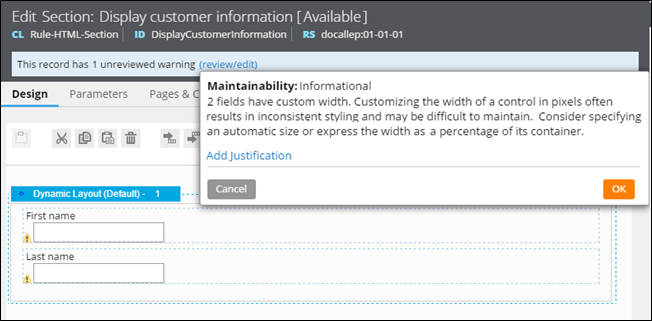Create, Save As, and Specialization forms
Valid from Pega Version 7.1.4
The familiar “New” and “Save As” forms have been streamlined to make record creation faster and more intuitive. You can easily target a specific layer in your application stack, interactively define the record’s configuration and select only those circumstance definitions that make sense for your use case.
While the underlying behavior for creating a record is not new for this release, the redesigned UI of these forms and new defaulting strategy for fields is worth noting:

To launch these forms, use one of the new options found in the action area of the form header:

Note that not all record types support the ability to specialize by circumstance.
For more guidance on how to use the Create, Save As and Specialization forms, please refer to: Intuitive record creation and specialization
Redirect users to logout screen
Valid from Pega Version 7.1.4
New applications built in Version 7.1 will automatically redirect users to the PRPC login page upon logout.
A new template, Web-Session-Return-Template, has been added, to allow developers to customize their applications to redirect users to a logout page, if they wish. This template can be copied to a ruleset visible to unauthenticated requestors (via node configuration) and used to override Web-Session-Return.
Source field not displaying in data transform
Valid from Pega Version 7.1.4
On the Data Transform rule form when using the Update Page action, if the Relation value is updated to “with values from”, the Source field will not be displayed.
(Note that for existing data transforms where the Source field has already been completed, this situation should not occur.)
Workaround
- Below is a data transform that has been configured to use Update Page.

- If a user were to choose an alternate source by updating the ‘with values from’ Relation value, they would not be prompted to provide a page name in the Source field.

- At this point, to be able to enter the Source page value, the user has to save the rule, which results in an error because the source page value is blank. This causes the field to appear.

- Once the field has appeared, the Source page value can be provided, and the form can be saved successfully.

Core Engine
Valid from Pega Version 7.1.4
This release contains fixes related to clipboard and declarative features, including data pages and autopopulate.
- A rule may be changed using Private Checkout, and then checked into a higher RuleSet Version for that RuleSet.
- Agents may now use a 24-hour time period for scheduling, as well as a 12-hour time period (which required the selection of AM or PM).
- Caching and performance have been enhanced.
- Declare expressions will work with embedded page lists when creating forms.
- Mandatory parameters on a data page can handle blank values.
- Properties may be auto-populated using a reference property which is created with a Property-Ref method in an activity.
- System will use "private edit" rules in developer's personal RuleSet when that rule overrides the "standard" rule available to all.
- The Page-Remove method will now remove Data Pages at the Thread level and the Requestor Level.
- When copying a page using the "Set" action on a data transform, the Declare Indexes defined on that data will be updated.
- When creating a data page, the Reload Once per Interaction checkbox can be checked to set the refresh strategy.
Designer Studio
Valid from Pega Version 7.1.4
Many refinements to the Designer Studio were made around performance and user experience. Based on feedback, we have made a number of bug fixes and strategic improvements that improve the overall user experience.
- The Developer Portal connects to the PDN's RSS feed without needing a DigiCert certificate for validation. The RSS feed is just headlines; to open and read any of the articles, users will still have to log into the PDN.
- Expression Builder has been enhanced to work with IE8.
- New applications built in Version 7.1 will automatically redirect users to the PRPC login page upon logout. A new template has been added, to allow developers to customize their applications to redirect users to a logout page, if they wish.
- Performance improvements were made when saving and validating rules.
- Performance of the Guardrails Dashboard has been improved.
- The display of circumstanced rules in Application Explorer has been enhanced.
Maintainable warning, error, and tip information
Valid from Pega Version 7.1.7
Use the redesigned Message form to define warning, error, tip, or custom category information in your application. Encapsulating these details in a message makes them easier to maintain and review. After you have created a new warning, you can quickly add it to a rule in your application using the new pxAddGuardrailMessage function.
For more information on the tabs and available fields on the Message form, see About Message rules.
Easy-to-browse warning catalog
Valid from Pega Version 7.1.7
All Pega 7 warnings have been converted to Rule-Message instances, each with a clearly written, risk mitigation path. This allows you to use the Records Explorer to browse through all warnings in the system, organized by category. To view warnings associated with specific rules in your application, refer to the Application Guardrails landing page.
Communicate guardrail compliance with the pxAddGuardrailMessage function
Valid from Pega Version 7.1.7
Now that guardrail warnings are in the model, you can easily attach them to rules in your application using the new pxAddGuardrailMessage function. Call this function to display warnings to your application users when they do not adhere to guardrails or best practices. Adopting this function in your application allows you to:
- Use localizable Rule-Message instances that are categorized by severity and application impact.
- Add dynamic warnings to your rules by passing parameters to a standard or custom message.
- Stop using and maintaining hard coded strings.

Design time view of warning messages

Run time view of an attached warning
This function supersedes the addWarning function, which has been deprecated. You can continue to use the CheckForCustomWarnings extension point, but it is recommended that you convert hard coded strings to messages and migrate any dependencies on addWarning to pxAddGuardrailMessage.
For more information on message attaching techniques, see Working with messages.
Track custom details with extensible messages
Valid from Pega Version 7.1.7
The customizable Message form gives you the freedom to expand upon default categories, store application specific data in a message, and enforce specialized validation. Leveraging these options makes it easier for you to identify a specific variety of message and incorporate new properties into your existing message processing logic.
For more details on which rules to override, see How to extend the Message form.
Collections more effectively model business decisions
Valid from Pega Version 7.1.7
Use the redesigned Collection form to model business logic or implement rule engine patterns in your application. This form is now located in the Decision rule category.
You can add response actions to each collection step to process return values transparently, and simplify your implementation by calling a function alias or when condition instead of an activity. Use one of the supported Stop methods to cease processing in the current collection or all collections in the call stack.
For more information on the available features on this rule form, see About Collection rules.

